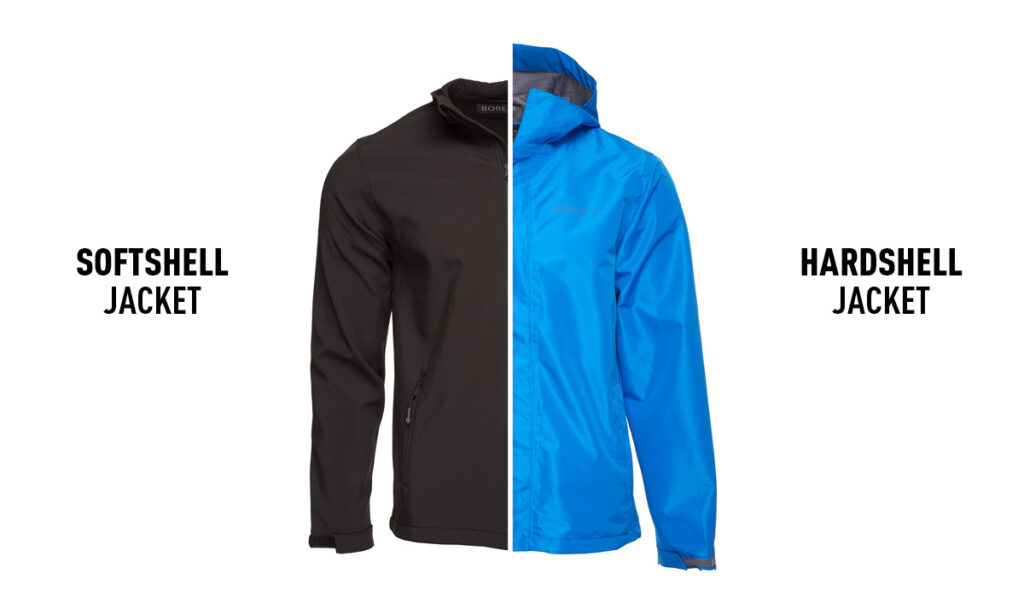The Best Winter Jackets for Every Weather
Winter Jackets | October 1, 2025
SAIL
November 5, 2021

To take full advantage of your outdoor activities during the winter season, the layering system is your best friend for braving the cold. However, each activity requires you to adapt your outfit, and this is why it can sometimes be difficult to choose appropriate clothing for an outdoor activity. Find out the differences between a soft shell and a hard shell jacket and how to make the right choice depending on the activities you plan on doing.
Through this article, learn more about:
Shop – Women’s shell jacketsShop – Men’s shell jacketsShop – Maintenance and cleaning accessories
Soft shell jackets are made of different materials, such as polyester and nylon, to form a durable, yet comfortable combination. This type of jacket is ideal for certain types of activities and weather conditions. The hard shell jacket is made of high-performance, waterproof materials and is designed for extreme temperatures.

The soft shell jacket is best used for outdoor activities that require a certain amount of physical effort, such as cross-country skiing, snowshoeing, or alpine touring. The main feature of the soft shell is its breathability. This type of jacket is particularly useful for activities where you are likely to sweat. Often made of stretchy nylon, the soft shell offers an excellent range of motion, allowing you to move comfortably during your outdoor adventures.
The soft shell has a very good windproof capacity, but will not be waterproof. However, it is water and weather resistant. Indeed, most soft shells are equipped with a water repellent treatment, which allows water to bead on the outer nylon fiber. Moreover, it is possible to renew this water-repellent treatment every season to optimize the jacket’s resistance and durability.
The soft shell jacket provides excellent wind resistance. To allow for optimal moisture exchange, the soft shell will not block all of the wind. For a cold and windy activity, it is better to choose a soft shell rather than a hard shell, for the simple reason that it will allow for better breathability and range of motion.
Soft shell jackets offer some protection against the cold, thanks to their interior which is often made of microfleece. This optimizes the degree of insulation and allows the jacket to be optimal for cooler temperatures. Soft shells are most effective when layered with other layers of clothing. These are generally designed to be intermediate layers. This technique will increase the cold protection capability of your soft shell.
Shop – Women’s shell jackets
Shop – Men’s shell jackets
The hard shell is known to offer less breathability and range of motion than the soft shell. This is why it is advantageous during outdoor activities that require less physical effort or when the weather is not on your side. For example, a hard shell is optimal for hiking and is usually used as an outer layer in the multi-layer system.
Hard shells offer excellent protection against water and extreme weather, such as heavy rain or snowstorms. The hard shell offers better waterproofing than the soft shell because of the fabrics it is made of. Often made of Gore-Tex, this type of jacket allows you to enjoy your favorite outdoor activities, even in the rain!
Hard shells provide full protection against all weather conditions. They are designed for specific weather conditions: rain, snow, gusts of wind, or high humidity; hard shells can withstand all weather conditions.
Like the soft shell, the hard shell offers some protection from the cold. Typically designed to be worn as an outer layer, the insulating layer underneath the hard shell allows the body to retain heat. In short, for optimal cold protection with either a soft or hard shell, be sure to wear layers.
The maintenance of soft and hard shells plays a big role in their effectiveness over time. Each material has its own characteristics, so you can refer to the directions on the labels of your shells.
Generally, they can be machine washed on a gentle cycle. Before washing them, it is recommended to close all zippers. Also, make sure the temperature is very low, and do not add fabric softener. For drying, it is best to air dry them and not put them in the dryer.
After washing, you can apply water-repellent treatments to keep your shell waterproof and use it for a long time.